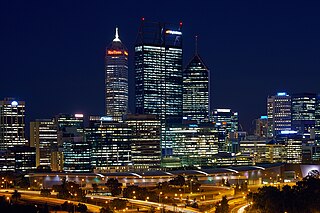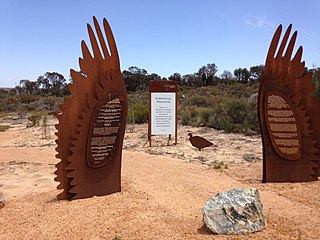
The Western Australia Police Force, colloquially WAPOL, provides police services throughout the state of Western Australia, an area of 2.5 million square kilometres, the world's largest non-federated area of jurisdiction, with a population of only 2.474 million, of which 2.14 million reside in the Perth Metropolitan Region.

The Claremont serial killings is the name given by the media to a case involving the disappearance of an Australian woman, aged 18, and the killings of two others, aged 23 and 27, in 1996–1997. After attending night spots in Claremont, a wealthy western suburb of Perth, Western Australia, all three women disappeared in similar circumstances leading police to suspect that an unidentified serial killer was the offender. The case was described as the state's biggest, longest running, and most expensive investigation.
This is a timeline of major crimes in Australia.

Brenden James Abbott is a convicted Australian bank robber. He is reported to have stolen and hidden millions of dollars, and was dubbed "the postcard bandit" by police seeking media coverage.
Christopher Dale Flannery, nicknamed "Mr. Rent-a-Kill" is alleged to have been an Australian contract killer.

Dante Wyndham Arthurs is an Australian murderer, convicted of the murder of eight-year-old Sofia Rodriguez-Urrutia Shu.

Stirling Gardens is a small public park in Perth, Western Australia.
The Forrest River massacre, or Oombulgurri massacre of June 1926, was a massacre of Indigenous Australian people by a group of law enforcement personnel and civilians in the wake of the killing of a pastoralist in the Kimberley region of Western Australia.

Estelle Blackburn is an Australian writer who has played a crucial role in the review of some controversial criminal cases in Western Australia.
Shirley June Finn, née Shewring, an Australian brothel keeper, nightclub operator and socialite who was shot dead at about midnight on 22–23 June 1975 in Perth, Western Australia. Her body, dressed in an elaborate ball gown and expensive jewellery, was found at dawn in her car, which was parked on a golf course next to a busy freeway. The murder is notable because of Finn's close relationship with Western Australia Police detectives who, in that era, controlled and regulated Perth's prostitution and gambling activities. The crime remains unsolved. A coronial inquest held between 2017 and 2020 returned an open finding with an acknowledgement that "it was most likely she was killed because she had tried to blackmail police about corruption."

Perth is a suburb in the Perth metropolitan region, Western Australia that includes both the central business district of the city, and a suburban area spreading north to the northern side of Hyde Park. It does not include the separate suburbs of Northbridge or Highgate. Perth is split between the City of Perth and the City of Vincent local authorities, and was named after the city of the same name in Scotland.

The Gold Stealing Detection Unit (GSDU), or Gold Stealing Detective Squad (GSDS), is a special unit of the Western Australian Police, based in Kalgoorlie, Western Australia. It investigates criminal activity and allegations at all stages of the gold production process in the state.
Brett Peter Cowan is an Australian murderer and child rapist. He was convicted of the murder of Daniel Morcombe, a 13-year old boy who disappeared from the Sunshine Coast on 7 December 2003. His abduction led to an eight-year investigation involving various suspects, until an undercover police sting in August 2011 revealed Cowan as the perpetrator. He was charged with the murder that same month and Morcombe's remains were discovered days later on 17 August. Cowan was sentenced to life imprisonment, on 13 March 2014 in a trial that attracted worldwide attention. Cowan had two previous convictions for sexually abusing children, the earliest dating back to 1987.

Adrian Donohoe was an Irish detective in the Garda Síochána based at Dundalk Garda Station in County Louth, who was fatally shot in Bellurgan on 25 January 2013 during a robbery by an armed gang of five people on a credit union. He was the first garda officer to be murdered in the line of duty since 1996, and was afforded a full state funeral.

The Kukenarup Memorial is a memorial 15 kilometres (9.3 mi) west of Ravensthorpe, Western Australia that commemorates the killing of many Noongar people following the death of John Dunn, whose family had taken out a pastoral lease in the 1870s. Reports of the incidents vary. The Memorial to the historical incident was opened in May 2015 in the region. Accounts agree that John Dunn was killed in 1880. Yandawalla (Yungala) was arrested and charged with the crime. Dartaban was also involved, and was a witness in the trial of Yandawalla (1881). Yandawalla was acquitted of the murder of John Dunn. Reprisal killings of a number of Noongar people occurred, seemingly both prior to and following that acquittal. John Dunn's grave is at Cocanarup Homestead.
On 12 March 2007, Frank Newbery was beaten to death inside his convenience store, Frank's Ham & Beef, in the inner-city suburb of Cooks Hill in the Australian city of Newcastle. The New South Wales Government offers a reward of $100,000 for any information leading to an arrest and conviction. As of October 2021, the case remained unsolved.











